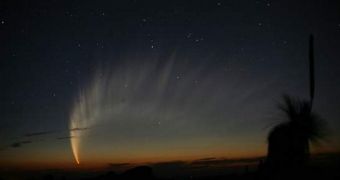About three years ago, astronomers, astrophysicists and skywatchers had the opportunity to behold one of the most spectacular comets to have entered the inner solar system for many years. Called C/2006 P1 McNaught, the celestial body left an impressive mark in the sky, with a tail extending a considerable portion of the sky. In the years that passed since the space object visited our neighborhood, experts were able to determine that the structure is in fact the largest comet ever measured. The conclusion is not based solely on the size of the tail, Space reports.
In a fortuitous turn of events, the NASA/ESA Ulysses spacecraft crossed the tail of McNaught in 2007, passing right through the trail that the space object left behind. This allowed its scientific instruments to collect valid and pertinent measurements of the overall influence the comet had in space. This was the primary element that helped experts gage the actual size of the comet. Usually, the length of the tail is a sufficiently precise indicator of its size.
The group that performed the analysis was essentially trying to discover the size of the region of space that was “disturbed” when the comet passed through. The magnetometer data the 19-year-old Ulysses spacecraft sent back showed traces of decayed shock waves surrounding the comet. Astrophysicists believe that these were formed when solar winds, which are intense in the inner solar system, merged with ionized gas, released by the frozen nucleus of the comet. These interactions are what caused the solar wind in the region immediately around the comet to slow down very suddenly.
“It was very difficult to observe Comet McNaught's plasma tail remotely in comparison with the bright dust tail, so we can't really estimate how long it might be. What we can say is that Ulysses took just 2.5 days to traverse the shocked solar wind surrounding Comet Hyakutake, compared to an incredible 18 days in shocked wind surrounding Comet McNaught. This shows that the comet was not only spectacular from the ground, it was a truly immense obstacle to the solar wind,” said University College London (UCL) Mullard Space Science Laboratory expert Dr. Geraint Jones.
He shared the data with experts gathered in Glasgow, Scotland today, at the RAS National Astronomy Meeting (NAM) 2010. “The scale of an active comet depends on the level of out-gassing rather than the size of the nucleus. Comet nuclei aren't necessarily active over their entire surfaces; what we can say is that McNaught's level of gas production was clearly much higher than that of Hyakutake,” the expert adds. The latter comet, observed in 1996, is the current record-holder for the longest tail ever observed. The Ulysses spacecraft ended its mission in 2009.

 14 DAY TRIAL //
14 DAY TRIAL //